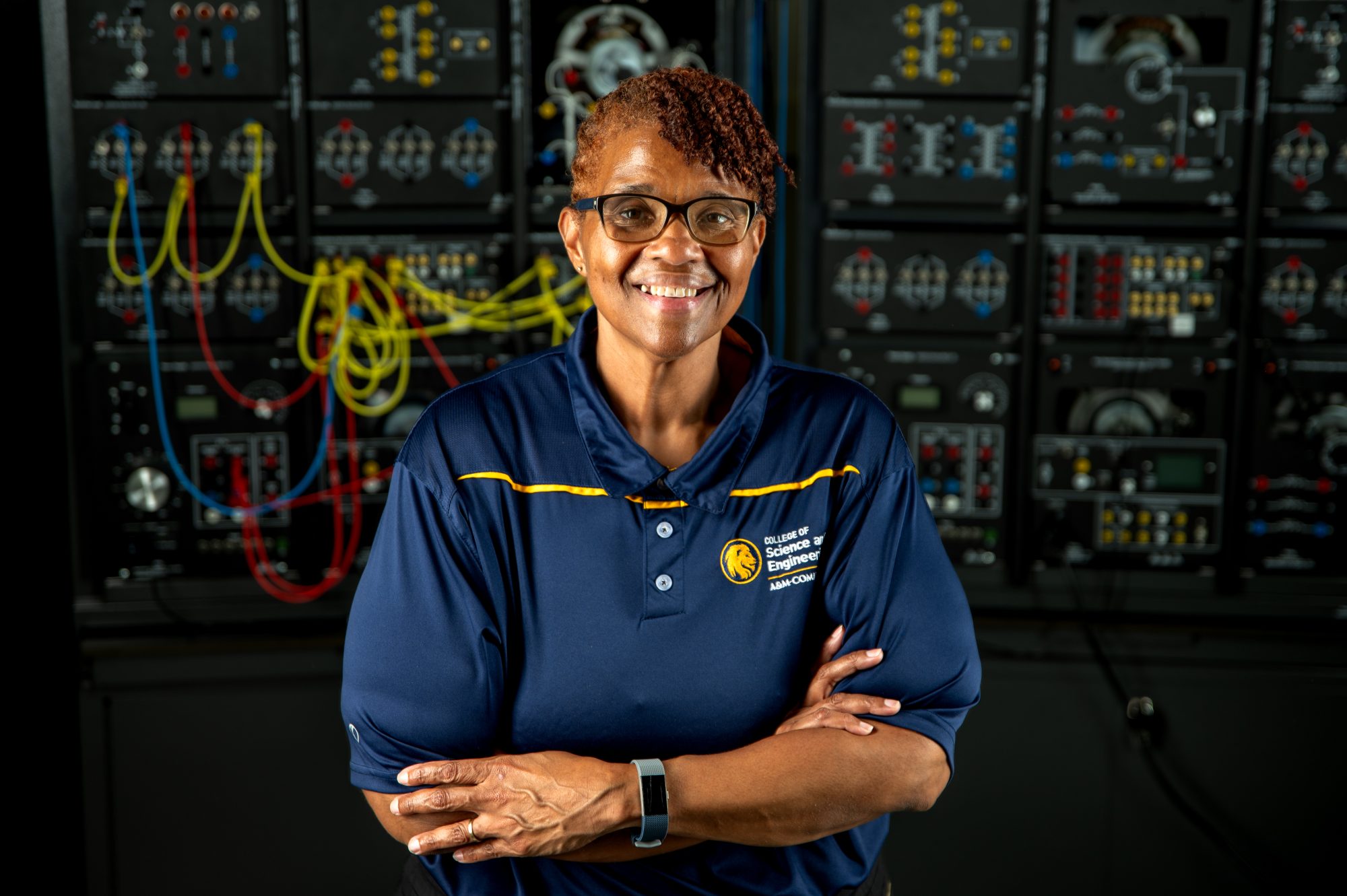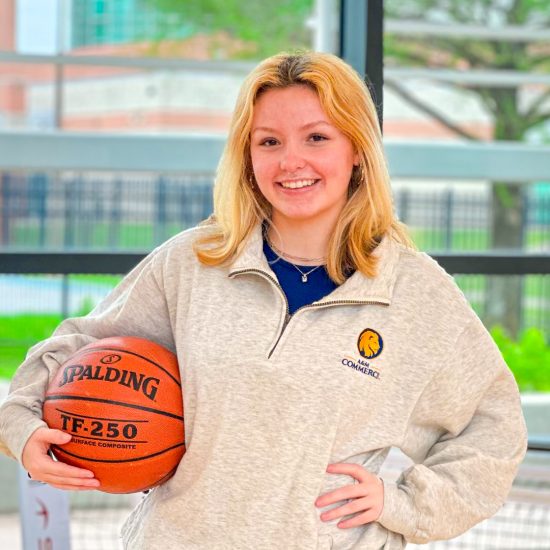TAMUC Science and Engineering Dean Builds Bridges for STEM Success
As a young girl growing up in rural Lee County, South Carolina, Dr. Andrea Toney Graham had “big dreams of doing big things.” Since then, she has blazed a pioneering trail through the STEM field, making a lasting impact through her scholarship and leadership.
Graham was the first engineer from her household and the first African American to earn a doctorate in industrial engineering from The University of Texas at Arlington (UTA). At Texas A&M University-Commerce, she was the first junior faculty member in the Department of Engineering and Technology to earn tenure and the first female tapped to lead the department. In Spring 2023, she became the first African American female to be named dean of the College of Science and Engineering at A&M-Commerce.

Gearing Up
Graham's parents both worked in manufacturing, sparking her early interest in STEM. The youngest of four, she shadowed her father and brother, tinkering around the house and “taking apart bicycles and everything else.”
She discovered her passion for engineering during her family's monthly—sometimes weekly—trips to watch air shows at Shaw Air Force Base in nearby Sumter, South Carolina.
“I would sit there for hours, watching the planes take off and land, thinking about how fascinating it was,” she said. “When I got to college, my major was aerospace engineering because I thought I wanted to be a pilot!”
Graham began studying aerospace engineering at Tuskegee University in Alabama, where she uncovered her determination to succeed as a female in a male-dominated field. After struggling in an engineering drafting course, a professor said she wouldn't make it as an engineer.
“I took that as a challenge,” she said. “I found my wings, my identity. Hope and resilience became my armor.”
While completing her undergraduate work, Graham interned with global aerospace manufacturer Pratt & Whitney. During her internship, several mentors speculated that mechanical engineering would offer a broader range of opportunities than the limited confines of the aerospace industry. After majoring in both subjects for a few semesters, she dropped aerospace and went on to graduate at the top of her class with a bachelor's degree in mechanical engineering.
She moved to Basking Ridge, New Jersey, in 1996 after landing a job at AT&T.
During her time with the company, Graham worked as a mechanical engineer, managing the lifecycle functions of building elements and developing corporate standards for HVAC system design and maintenance, overseeing multi-million-dollar programs focused on infrastructure repair and replacement and specializing in alarms monitoring and controls for domestic and international infrastructure.
She earned her master's degree in technology management from Stevens Institute of Technology in 2004.
Career 2.0: From Industry to Academia
After a decade in the private sector, Graham felt something was missing from her career. She liked working in industry but wanted to make a more tangible impact.
She left AT&T in 2004 and moved back to South Carolina to help with her ailing father. She began exploring a second career in education and enrolled at Clemson University to pursue a doctorate in industrial engineering.
Following her father's passing, she moved to Texas so she and her husband could access better work opportunities. She enrolled at UTA in 2008, became an Alfred P. Sloan Fellow and completed her doctorate in industrial engineering in 2012. She worked as an adjunct instructor at UTA for a short time before accepting a teaching position in the College of Science and Engineering at A&M-Commerce in 2013.
Building Representative Spaces in STEM
In her new role, Graham set out to bridge the gap between academia and industry.
“We're committed to building purposeful relationships, working together with industry leaders in applied sciences to help them gain a competitive edge and offer experiential learning opportunities for our students,” she said.
She also noticed that first-generation and underrepresented STEM students lacked the family and social support systems to access and succeed in higher education. She recognized the importance of creating representative spaces that inspire these populations to envision themselves succeeding in STEM careers.
To address this issue, Graham worked to acquire funding for middle school girls to attend camps designed to encourage their interest in STEM subjects and careers. Today, she continues her efforts to increase the percentage of females who pursue STEM careers and remain in academia. “There are a lot of places to be for women with a Ph.D.,” Graham said. “We're doing a better job recruiting young ladies into the field but keeping them in academia is another thing because they don't see many women in this space.”
Challenging the Status Quo
Graham is committed to challenging the expectations for women and minorities in engineering. She said people are accustomed to seeing women in the hard sciences but not so much in the engineering spaces, especially in leadership positions. She recalled several times when someone would dismissively look over her, refusing to acknowledge that she belonged in the engineering workspace.
“I've noticed that I have to be bold in these spaces,” Graham said. “I work in an industry full of men, so I've learned to be assertive. I say what I mean, and I mean what I say.”
She said the rewards are worth the challenges.
“The best reward is knowing that I'm contributing and bringing my perspective to the table,” Graham said. “Nobody is lessened because I'm in the space, and nobody is more because I'm there. We make each other better.”
She added: “That's the leadership I want to bring to the table. I want everyone in the space. I want faculty, staff and students to reach their full potential. If you've taken the time to come to this space and you're giving it your earnest time and effort, you should see a return. That's what I want to see happen for everyone.”
Growing STEM at A&M-Commerce
Graham aims for A&M-Commerce to gain regional and national recognition for its STEM-forward curriculum and impactful faculty- and student-led research. She hopes current and future Lions will help further integrate accessibility, collaboration and responsive innovation into STEM fields.
She believes the College of Science and Engineering holds the potential to serve as a cornerstone for growth at A&M-Commerce. She encourages faculty to harness innovations around artificial intelligence, sustainable infrastructure, renewable energies, and biotechnology to help advance medicine, infrastructure and other industries.
“That's what we are here to do … solve problems and make people's lives better,” Graham said.
Life and Career Advice
Noting the same insecurities she once felt, Graham advises students to believe in themselves and take risks. She remembers the difficult decision to leave the safety and success she experienced at AT&T.
“I learned that money is good but not all money is good money,” she said. “Chase what you're passionate about and the rest will fall into place.”
Graham recalls fondly the warm calls and messages she received from her Tuskegee classmates after she was named dean of the College of Science and Engineering at A&M-Commerce.
“They reminded me that I manifested this back in 1994,” she said. “Back then, I proclaimed that I would be a dean of engineering someday!”
Staying Grounded
Despite her accolades, Graham said she is still the same small-town girl who dreamed of working in aviation. Her husband, Andrew, and three sons, Joshua, Matthew and Elijah, are her biggest supporters. They remind her each day that she is equipped to do great things.
“I knew I was interested in STEM, but didn't think it was possible for me,” Graham said. “But with hard work and dedication, it became possible. Now I am working to build bridges that open doors for other young people who dream of becoming engineers and scientists.”
As for her next big accomplishment, Graham said her ultimate dream is to become a university president. If history is any guide, she's sure to make that happen, too.





